You start out in 1954 by saying, “Nigger, nigger, nigger.” By 1968 you can’t say “nigger”— that hurts you, backfires. So you say stuff like, uh, forced busing, states’ rights, and all that stuff, . . .
— Lee Atwater, Advisor to President Ronald Reagan, in 1981. 541 Rick Perlstein, “Exclusive: Lee Atwater’s Infamous 1981 Interview on the Southern Strategy,” The Nation, November 13, 2012.
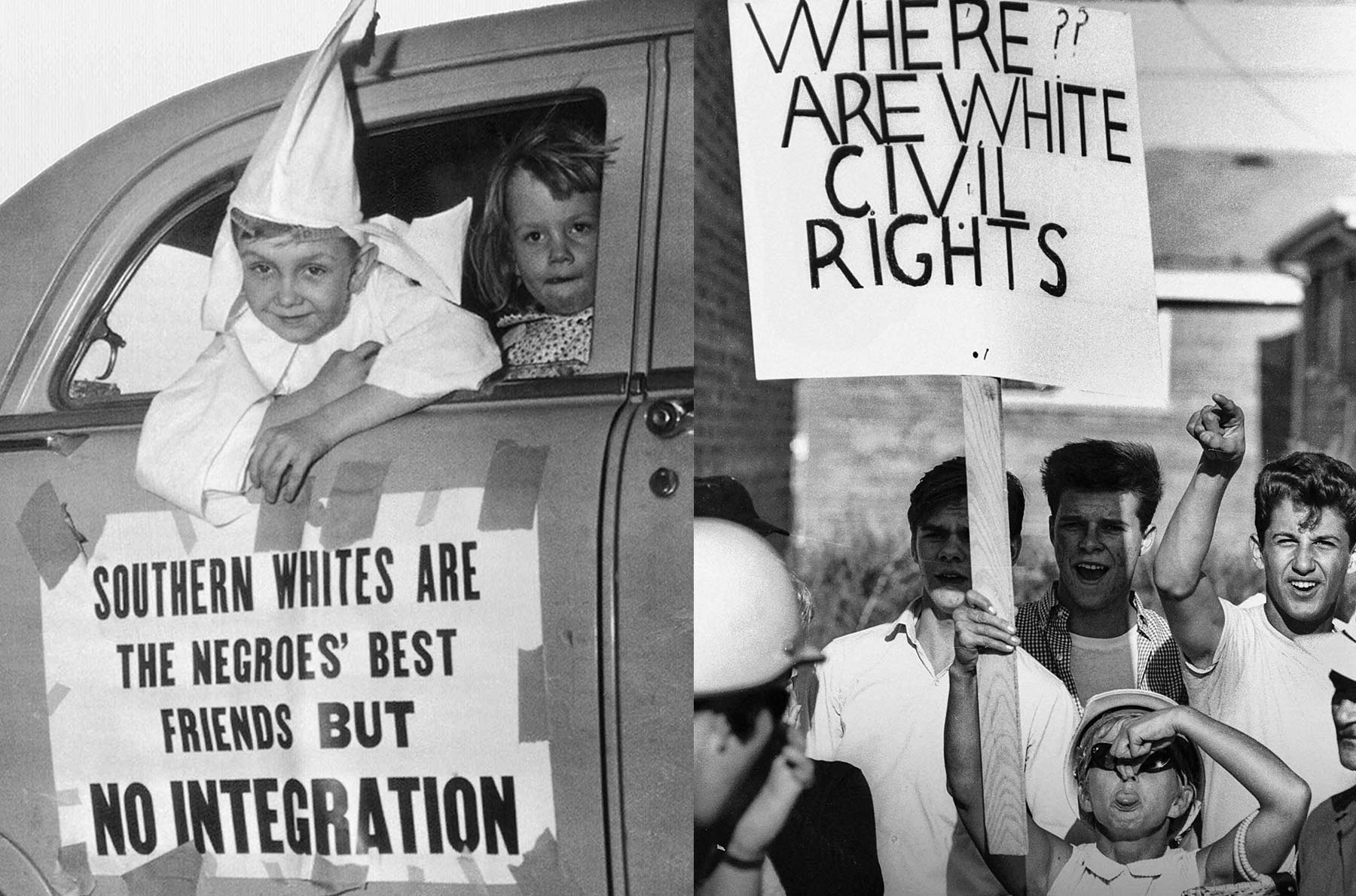
White children protest desegregation in Chicago, Illinois, 1966. (Declan Haun/Chicago History Museum) Seven-year-old dressed in Ku Klux Klansman robes rides in a Klan motorcade on August 14, 1956, in Macon, Georgia. (Bettmann/Getty Images)
By the dawn of the 1970s, the Civil Rights Movement had helped push the Supreme Court to declare segregation in public schools unconstitutional and led to the passage of significant laws like the Civil Rights Act of 1964, which outlawed racial discrimination in public accommodations and employment; the Voting Rights Act of 1965, which prohibited discriminatory voting practices; and the Fair Housing Act of 1968, which barred discrimination in housing sales, rentals, and financing.
But racial equality was not achieved by passing civil rights laws. The Civil Rights Movement did not eradicate the narrative of racial difference, and opposition to racial equality remained deeply rooted in the American way of life.
The evolution of voter suppression in the South and school segregation in the North demonstrate that, while civil rights activists won the legal battle, the cause of racial inequality once again won the narrative war.
The Voting Rights Act “literally changed the face of southern politics” by bringing widespread enfranchisement to Black communities for the first time since Reconstruction. 542 Richard K. Scher, Politics in the New South: Republicanism, Race, and Leadership in Twentieth Century (New York: Routledge, 1997), 250. Just three years after the law passed, Black voter registration in the South had increased by 1.3 million people. The greatest changes were in the states most targeted by the new law. In Mississippi, 60 percent of eligible Black voters were registered in 1968, up from just 7 percent in 1965. 543 Ibid. In Alabama, federal protection of Black voting rights directly led to the ouster of Dallas County Sheriff Jim Clark; he lost in 1966 to an opponent who publicly denounced his “mass arrest” tactics. 544 Rex Thomas, “Wilson Baker, Jim Clark To Fight For Sheriff’s Job,” Montgomery (Ala.) Advertiser, February 22, 1966; Lake Charles (La.) American-Press, “Baker Ruled Winner Over Sheriff Clark,” May 25, 1966; Stephan Thernstrom and Abigail Thernstrom, America in Black and White: One Nation, Indivisible (New York: Touchstone, 1999), 157.
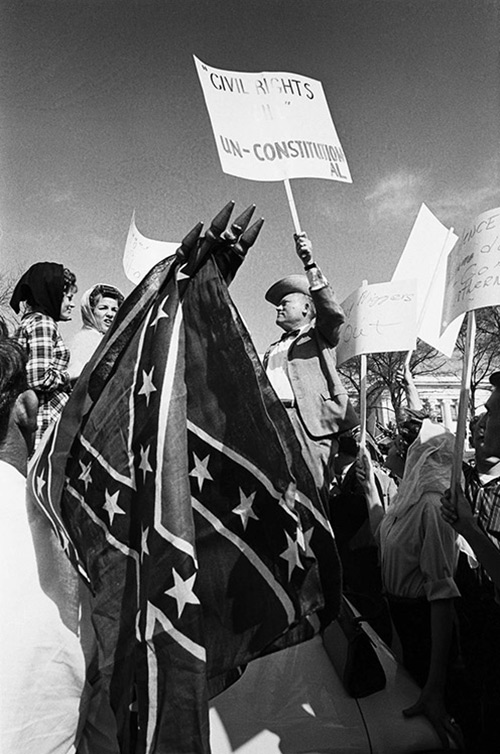 In this 1965 photograph, a man in Alabama
holds a large sign protesting the Civil
Rights Act. Others hold Confederate flags,
which became a symbol of resistance to
desegregation. (© Spider Martin)
To stay in power as the South gained more than a million Black voters, segregationists needed to suppress the Black vote, so they began calling themselves “conservatives” and added more sophisticated tools to their repressive repertoire.
In this 1965 photograph, a man in Alabama
holds a large sign protesting the Civil
Rights Act. Others hold Confederate flags,
which became a symbol of resistance to
desegregation. (© Spider Martin)
To stay in power as the South gained more than a million Black voters, segregationists needed to suppress the Black vote, so they began calling themselves “conservatives” and added more sophisticated tools to their repressive repertoire.
One tool was the voter fraud allegation, wielded in 1985 by then-United States Attorney Jeff Sessions against Black voting rights activists in Alabama. Sessions targeted only Black defendants, including civil rights icon Albert Turner,
a former aid to Martin Luther King Jr. who was beaten in Selma on Bloody Sunday.
When critics pointed out that Sessions had targeted Black people exclusively, he insisted, “We will respond to any substantiated charge of vote fraud against whites or Blacks. I know of no charges against white election officials in my
jurisdiction.” But Sessions was not responding to charges of voter fraud against the Marion Three — his office initiated the cases
545
Michael Hirsley, “Alabama Torn By Vote-Fraud Charges,” Chicago
Tribune, June 17, 1985.
because, as Mr. Turner observed, “I stand in the way of the white power structure.”
546
Marie Prat, “3 Acquitted of Fraud in Ala. Voting,” Philadelphia (Pa.)
Inquirer, July 6, 1985.
The Marion Three were acquitted, but the “voter fraud” narrative remained a popular tactic to restrict and intimidate Black voters and their advocates.
Another tactic that became common in the 1980s is voter caging — the practice of sending mail to addresses on the voter rolls, compiling a list of the mail that is returned undelivered, and purging voters on that list on the ground that
they do not legally reside at their registered addresses.
547
Justin Levitt, “Reported Instances of Voter Caging,” Brennan
Center for Justice, June 29, 2007, https://www.brennancenter.org/
analysis/reported-instances-voter-caging.
Proponents defended caging as a way to identify voter fraud but Republican officials targeted Black and Latino neighborhoods for voter purges. A 1981 internal Republican National Committee memo about caging in Louisiana read, “I know this
race is really important to you. I would guess that this program will eliminate at least 60-80,000 folks from the rolls . . . If it’s a close race, which I’m assuming it is, this could keep the Black vote down considerably.”
548
John Kass, “116,541 Voters Must Re-Register,” Chicago Tribune,
February 17, 1986; Chandler Davidson et al., “Republican Ballot
Security Programs: Vote Protection or Minority Vote Suppression or
Both?” Center for Voting Rights and Protection (2004): 17, http://
www.votelaw.com/blog/blogdocs/GOP_Ballot_Security_Programs.
pdf.
A state judge later ruled that the program’s clear intent was to remove African Americans from the voter rolls.
549
Thomas B. Edsall, “‘Ballot Security’ Effects Calculated,” Washington
Post, October 25, 1986.
Jesse Helms was elected to the Senate from North Carolina in 1973. A white Republican, he had supported I. Beverly Lake’s segregationist campaign for governor in 1960, and actively relied on voter caging
550
Justin Levitt and Andrew Allison, Reported Instances of Voter Caging
(Brennan Center for Justice, June 2007), http://www.brennancenter.
org/sites/default/files/legacy/d/download_file_49609.pdf
and other racialized tactics.
In 1984, Helms overcame a 20-point deficit after he published literature warning voters about Black registration drives and filibustered the bill that sought to make Martin Luther King Jr.’s birthday a national holiday.
551
David S. Broder, “Jesse Helms, White Racist,” Washington Post, July
7, 2008.
In the twilight of his tenure, while Helms was a guest on the Larry King Live show, a caller thanked him for “everything you’ve done to help keep down the niggers.”
552
Langdon Morris, The War For America: Morality, Ideology, and the
Big Lies of American Politics (Lincoln: iUniverse, Inc., 2004), 60.
Helms retired in 2003 at age 81.
553
New York Times, “‘Senator No’ Says Goodbye,” August 23, 2001.
In 2010, Alabama’s Republican-controlled state government filed a lawsuit challenging the Voting Rights Act as “no longer necessary.” 554 Miranda Blue, “Alabama County Brings the Voting Rights Act to Court,” People for the American Way, September 9, 2010, http://www. pfaw.org/blog-posts/alabama-county-brings-the-voting-rights-actto-court/. Three years later, in Shelby County v. Holder, a divided Supreme Court effectively gutted the Voting Rights Act by striking down the requirement that states like Alabama obtain “pre-clearance” from the federal government before changing their voting laws. 555 Shelby County, Ala. v. Holder, 570 U.S. 529 (2013). In dissent, Associate Justice Ruth Bader Ginsburg wrote that the Court was turning its back to history. “The sad irony of today's decision lies in its utter failure to grasp why the [Voting Rights Act] has proven effective,” she wrote.
Throwing out preclearance when it has worked and is continuing to work to stop discriminatory changes is like throwing away your umbrella in a rainstorm because you are not getting wet. 556 Ibid., 590.
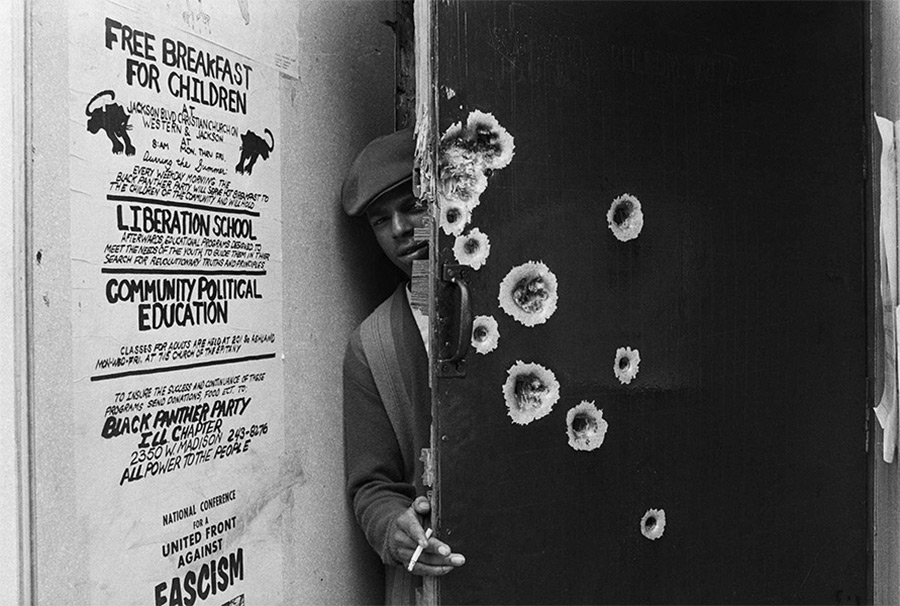
A young man peeks from behind a door at a Black Panther Party meeting space in Chicago on August 5, 1969, days after police blasted the building with gunfire. Party leader Fred Hampton was killed by Chicago police just months later. (Bettmann/Getty Images)
In the pre-dawn hours of December 4, 1969, Chicago police working with the Federal Bureau of Investigation (FBI) raided the Black Panther Party’s local headquarters.
557
Jeffrey Haas, The Assassination of Fred Hampton (Chicago: Chicago
Review Press, 2010); Jeff Cohen and Jeff Gottlieb, “Was Fred Hampton
Executed?” The Nation, December 25, 1976.
Fred Hampton’s personal bodyguard, William O’Neal, was an FBI informant and gave officers a floor plan before the raid.
558
Hass, Assassination of Fred Hampton, 221.
When the smoke cleared, Hampton and Mark Clark were dead and four others had been seriously wounded.
559
Ibid.
During the civil rights era, law enforcement targeted Black leaders for arrest, surveillance, propaganda, and violence. Leaders of bus boycotts in Montgomery, Alabama, and Tallahassee, Florida, in 1956, were harassed, arrested, and
fined.
560
Klarman, From Jim Crow to Civil Rights, 412; Atlanta (Ga.) Daily
World, “Leaders of Bus Protest Group Fined in Fla.,” October 21, 1956;
Baltimore (Md.) Afro-American, “‘Ride Buses or Go to Jail,’ Fla. Warns:
Arrest 22, Grab Books of Drivers,” October 13, 1956; Chicago Defender,
“Boycotters Fined $500,” October 27, 1956; Norfolk (Va.) Journal and
Guide, “Florida Bus Boycotters Appeal $11,000 Fines,” October 27,
1956.
That year, the FBI launched COINTELPRO, a counterintelligence program focused on “domestic threats,” including civil rights activists.
561
James Kirkpatrick Davis, Spying on America: The FBI’s Domestic
Counter-Intelligence Program (Westport: Praeger Publisher, 1992), 36.
Black leaders committed to racial justice represented a threat to white supremacy and became targets of law enforcement harassment and attack even when they advocated nonviolence. Beginning in 1963, for example, Dr. Martin Luther King
Jr. “was the target of an intensive campaign by the Federal Bureau of Investigation to ‘neutralize’ him as an effective civil rights leader” and destroy his image as a “potential messiah” to unify Black activists.
562
“Final Report of the Select Committee to Study Governmental
Operations with Respect to Intelligence Activities,” U.S. Senate (April
26, 1976): 11-12.
When a younger generation began to steer the movement in a different direction, law enforcement repression intensified.
563
“The ‘Fed Up’ Generation Talks About Negro Rights and the
American Future,” Negro Digest (1966): 18.
("Most of the old-line Negroes continue to hope that the
American society will honor its principles and eventually
admit them. An increasing number of younger Negroes not
only do not believe the nation can abandon its heritage of
racism, but they also believe that full freedom and equality is
possible only in an America that has undergone radical changes.
These younger Negroes are fed up with what they consider the
broken promises, the endless hypocrisy and the deceit with
which the society confronts their demand for justice").
Malcolm X, who believed “[i]t is criminal to teach a man not to defend himself when he is the constant victim of brutal attacks,”
564
Malcolm X, Malcolm X Speaks: Selected Speeches and Statements
(New York: Grove Press, 1994), 22.
was constantly surveilled by police up until he was assassinated in 1965.
565
“Final Report of the Select Committee,” 63; Jonathan David Farley,
“Preventing the Rise of a Messiah,” The Guardian, April 4, 2008 (“While
the guns that killed Malcolm X were held by Black hands, we now
know that his bodyguard the day he was shot was an undercover police
agent, who later infiltrated the New York chapter of the Black Panther
party and charged many of its leaders with various crimes.”).
In July 1966, 25-year-old SNCC chairman Stokely Carmichael gave a speech invoking Malcolm X’s memory and advocating a self-determination policy of “Black Power.”
566
“‘Fed Up’ Generation,” 18.
A few months later, two Black men named Huey P. Newton and Bobby Seale formed the Black Panther Party for Self Defense in Oakland, California.
567
Jama Lazerow and Yohuru Williams, In Search of the Black Panther
Party: New Perspectives on a Revolutionary Movement (Durham: Duke
University Press, 2006), 39.
Spurning the tactics of marches, sit-ins, and boycotts, the Panthers founded youth centers and free breakfast programs and organized legally armed patrols to prevent police brutality.
568
Ibid., 80.
University Press, 2006), 39.
President Lyndon B. Johnson publicly condemned the concept of “Black Power” that the Panthers symbolized.
569
Don Irwin, “Johnson Critical of Black Power Crusades: Goes Out
of His Way to Advise Against Drives Being Pressed by CORE, SNCC,”
Los Angeles Times, July 6, 1966.
The rise of militant Black activism and its rejection by white stakeholders emboldened law enforcement officials to employ controversial — and sometimes deadly — tactics. In August 1967, the FBI officially directed COINTELPRO to “expose,
disrupt, misdirect, discredit, or otherwise neutralize” Black nationalist groups.
570
Brian Glick, War at Home: Covert Action Against U.S. Activists and
What We Can Do About It (Cambridge: South End Press, 1989), 77.
In July 1969, FBI Director J. Edgar Hoover named the Black Panther Party “the greatest threat to the internal security of the country.”
571
Desert Sun, “Black Panther Greatest Threat to U.S. Security,” July
16, 1969.
Federal agents and local police engaged in harassment and raids that led to violent shootouts and the deadly ambush that killed 21-year-old Fred Hampton. An April 1970 poll, however, showed that 75 percent of Americans blamed the Panthers
for this police violence.
572
Giovanni Russonello, “Fascination and Fear: Covering the Black
Panthers,” New York Times, October 15, 2016.
“[M]any of the tactics employed by the FBI were indisputably degrading to a free society,” a Senate committee concluded in 1976, five years after COINTELPRO shut down.
573
Glick, War at Home, 7-8.
The committee reported:
During 1967-1971, FBI headquarters approved 379 proposals for COINTELPRO actions against ‘Black nationalists.’ These operations utilized dangerous and unsavory techniques which gave rise to the risk of death and often disregarded the personal rights and dignity of the victims. 574 “Final Report of the Select Committee,” 10-11.
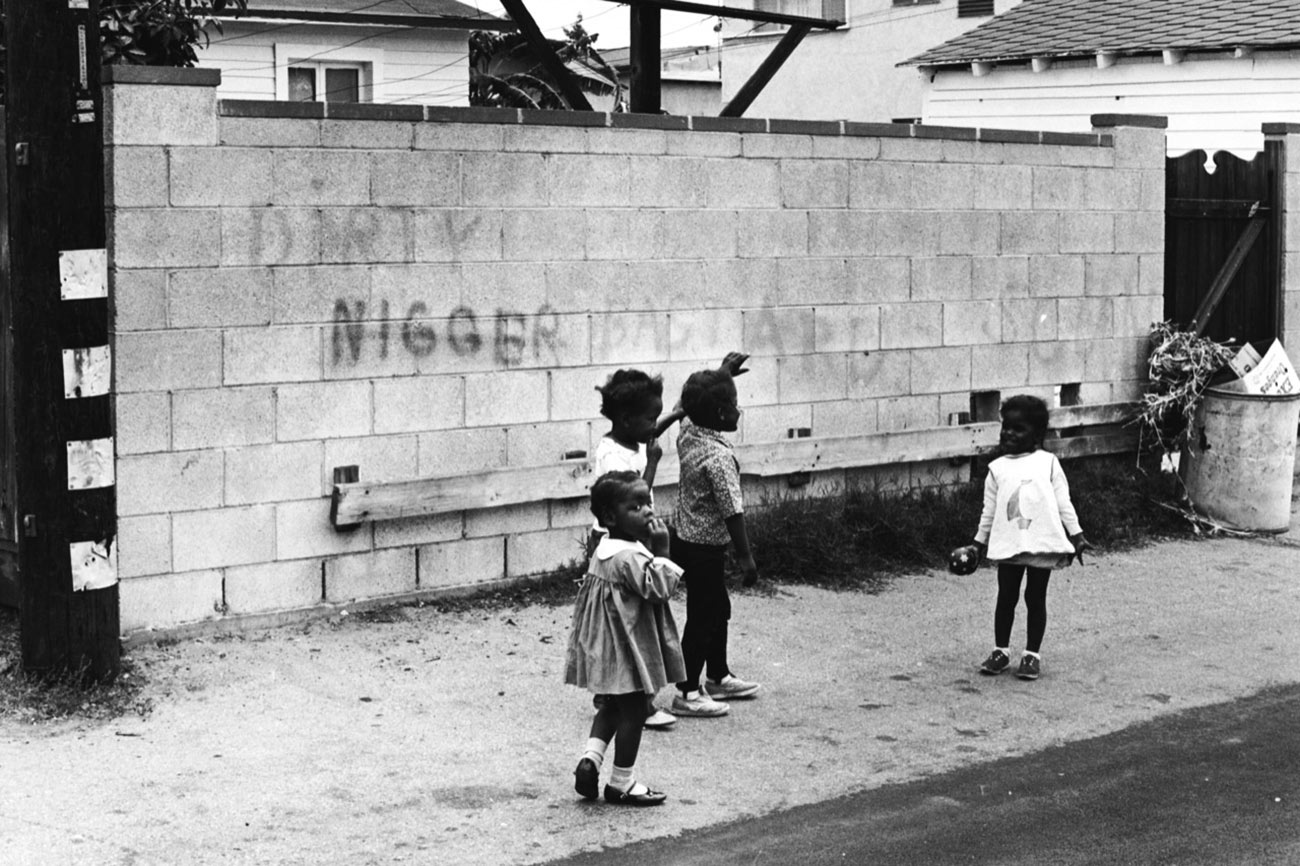
Young girls in Los Angeles play in front of a wall marked with a hateful epithet. (© Joe Schwartz; www.joeschwartzphoto.com)
Outside the South, residential segregation was a driving force of school segregation before and after the civil rights era. In 1970, average residential segregation in Northern and Western population centers was even higher than in the South — more than
four out of five Black residents lived in segregated neighborhoods.
575
Douglas S. Massey and Nancy A. Denton, American Apartheid
(Cambridge: Harvard University Press, 1998), 47.
Residential segregation was “manufactured by whites through a series of self-conscious actions and purposeful institutional arrangements.”
576
Ibid., 2.
After the Fair Housing Act of 1968 barred white homeowners from explicitly refusing to rent or sell to Black people, “[r]ealtors no longer refused outright to rent or sell to Blacks . . . but real estate agents continued to practice surreptitious
and widespread discrimination,” such as excluding listings from predominately Black newspapers and lying to Black home seekers about the availability of apartments.
577
Ibid., 84
Audits revealed such rampant housing discrimination in St. Louis in 1969 that four realty companies were forced to sign a consent decree with the Department of Justice. In Palo Alto, California, a 1971 study found that Black people experienced
discrimination in 50 percent of apartment complexes, while a 1976 investigation in suburban Baltimore uncovered discrimination in more than 45 percent of cases.
578
Ibid., 98-99.
Home ownership was no solution, as banks often rejected mortgage applications from qualified Black buyers.
579
Ibid., 108.
These practices made it difficult for Black families to move into white neighborhoods, which in turn made it difficult to meaningfully integrate schools.
To implement Brown during the 1970s, courts ordered the transportation of Black and white students to public schools outside of their neighborhoods. In 1971, the Supreme Court upheld courts’ authority to order busing
580
Swann v. Charlotte-Mecklenburg Bd. of Educ., 402 U.S. 1 (1971).
and many school districts implemented busing plans in the 1970s and 1980s. In response, white families across the country organized opposition to “forced busing” that mirrored Southern opposition to school desegregation.
“I favor segregation,” Orville Hubbard, mayor of Dearborn, Michigan, explained to the New York
Times in 1968. “Because if you have integration, first you have kids going to school together, then next thing you know, they’re grab-assing around, then they’re getting married and having half-breed kids. Then you wind up with a mongrel race.
And from what I know of history, that’s the end of civilization.”
581
Susan Morse, “Dearborn Lowers its Flag for its 36-Year Ruler,”
Detroit Free Press, December 17, 1982.
Hubbard’s supporters kept him in office from 1942 to 1978.
582
Port Huron (Mich.) Times Herald, “Colorful Dearborn Mayor Orville
Hubbard Dies,” December 16, 1982.
New York Governor Nelson Rockefeller signed a bill to outlaw busing in 1969, but the law was later deemed unconstitutional.583
Matthew Delmont, Why Busing Failed: Race, Media, and the National
Resistance to School Desegregation (Berkeley: University of California
Press, 2016), 52; Ithaca (N.Y.) Journal, “Integration by Busing Gets
Senate ‘No,’” April 20, 1966.
In Boston in 1974, after a federal court ordered the local school committee. To propose a desegregation plan, the committee chairman, John Kerrigan, voted to defy the order and develop no plan. “This is a vote against those maggots that
live outside the city,” he announced. “And it’s the proudest vote I’ve cast in seven years on this committee.”
584
New York Times, “Judge in Boston Defied on Busing,” December 17,
1974; Minneapolis (Minn.) Star Tribune, “Boston Ordered to Integrate,”
June 22, 1974.
Senate ‘No,’” April 20, 1966.
That September, after court-ordered busing began in Boston, white mothers led the opposition.
585
Elizabeth Gillespie McRae, Mothers of Massive Resistance: White
Women and the Politics of White Supremacy (New York: Oxford
University Press, 2018), 22 4-33.
White mobs attacked buses carrying Black students to white schools with eggs, bricks, and bottles. Protestors, students, and bystanders alike were stoned, stabbed, and beaten in clashes that continued for weeks until quelled by the National
Guard.
586
Fitchburg (Mass.) Daily Sentinel and Leominster Enterprise, “Five
Arrested in Boston Over Protest of Busing,” September 24, 1974;
Pittsfield (Mass.) Berkshire Eagle, “Beefed-up Protection by Police Cools
Boston Anti-Busing Violence,” September 16, 1974; Fitchburg (Mass.)
Daily Sentinel and Leominster Enterprise, “Text on Sargent Troop Call,”
October 16, 1974.
Northern segregation activists distinguished themselves from “unsophisticated racist Southerners” by focusing on their identities as mothers concerned about school safety, quality, and cohesiveness.
587
McRae, Mothers of Massive Resistance, 34.
In Michigan, anti-busing crusader Irene McCabe declared, “We are not racists. We respect the Blacks. Our concern is with education.”
588
Peter Arnett, “More Schools Integrated in the South,” San Bernardino
County (Calif.) Sun, December 26, 1971.
Louise Day-Hicks, former Boston mayoral candidate and founder of the anti-busing group Restore Our Alienated Rights (ROAR), staunchly opposed busing but avoided public racism: “I am not a racist. You show me where I have said anything against
. . . Negroes.”
589
Carol Liston, “Louise Day Hicks: Next in City Hall?,” Louisville
(Ky.) Courier Journal, September 28, 1967.
In Boston in 1974, school committee chairman, John Kerrigan, voted to defy the order and develop no plan. “This is a vote against those maggots that live outside the city,” he announced. “And it’s the proudest vote I’ve cast in seven years on this committee.”
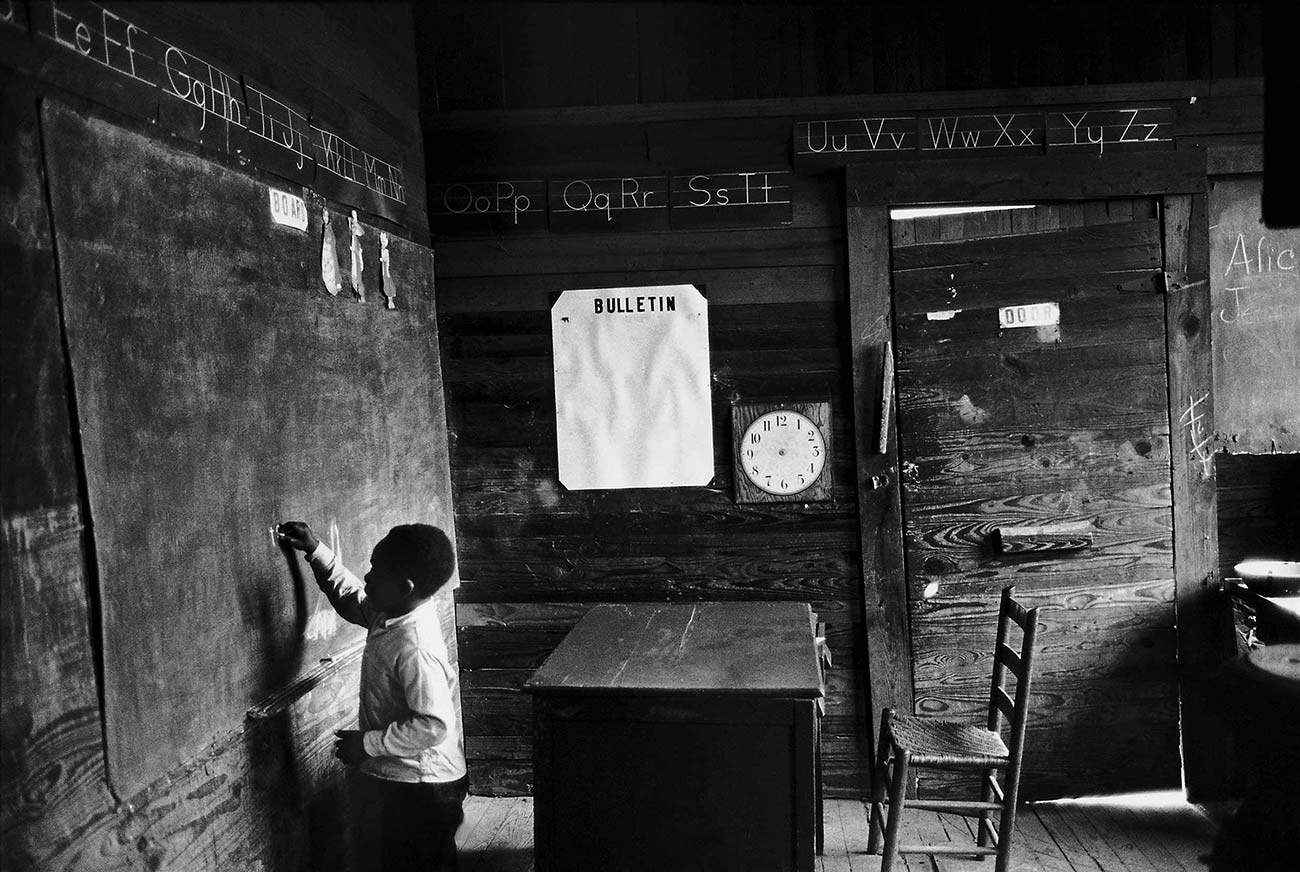
A grade school student draws on a chalkboard in a one-room schoolhouse in Selma, Alabama, in March 1965. A decade after Brown, schools continued to be separate and unequal. (Bruce Davidson/Magnum Photos)
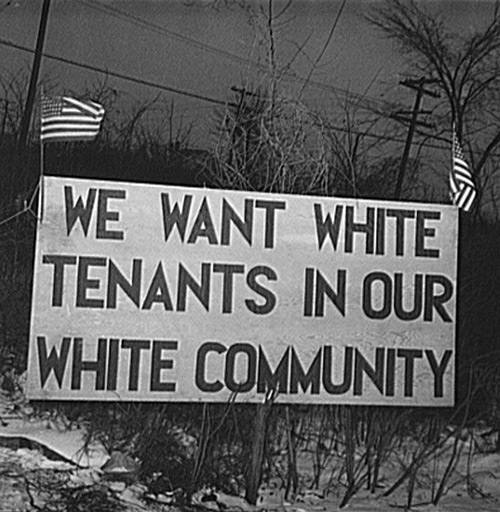 A sign mounted in February 1942, directly
across from the Sojourner Truth Homes, a
federal housing project in Detroit, Michigan.
White residents rioted when their Black
neighbors attempted to move in. (Library of
Congress)
But the racial motivations were barely obscured just below the surface. “White motherhood meant teaching their children lessons in racial distance, in a racially determined place in society, and in white superiority,” wrote historian Elizabeth Gillespie
McRae. “Whiteness had so infused definitions of motherhood in the Jim Crow South and a Jim Crow nation that they could hardly be separated.”
590
McRae, Mothers of Massive Resistance, 237.
A sign mounted in February 1942, directly
across from the Sojourner Truth Homes, a
federal housing project in Detroit, Michigan.
White residents rioted when their Black
neighbors attempted to move in. (Library of
Congress)
But the racial motivations were barely obscured just below the surface. “White motherhood meant teaching their children lessons in racial distance, in a racially determined place in society, and in white superiority,” wrote historian Elizabeth Gillespie
McRae. “Whiteness had so infused definitions of motherhood in the Jim Crow South and a Jim Crow nation that they could hardly be separated.”
590
McRae, Mothers of Massive Resistance, 237.
Mass organizing against busing forced school boards across the country to demand that courts lift or weaken busing mandates. As early as 1977, federal courts agreed to lift a busing order imposed on Oklahoma City schools just five years
earlier after concluding that integration had been achieved.
591
David J. Armor, Forced Justice: School Desegregation and the Law
(New York: Oxford University Press, 1995), 52-53.
Boston’s desegregation plan was ruled successful in 1987.
592
Allan R. Gold, “Boston Ready to Overhaul School Busing Policy,”
New York Times, December 28, 1988
Residential segregation remained so persistent that sociologists observed, “No group in the history of the United States has ever experienced the sustained high level of residential segregation that has been imposed on Blacks in large American cities
for the past fifty years.”
593
Massey & Denton, American Apartheid, 2, 222.
In 1980, the 18 Northern cities with the largest African
American populations had an average segregation index of
80.1, and by 1990 that average had only fallen slightly to 77.8.
On January 15, 1991, the Supreme Court nonetheless declared that federal school desegregation injunctions were intended to be temporary and made it easier for schools to end busing and other desegregation policies.
594
Bd. of Educ. of Oklahoma City v. Dowell, 498 U.S. 237 (1991).
A decade later, researchers found that, due to relaxed court oversight, school districts across the nation — particularly in the South — were re-segregating at an alarming rate.
595
Gary Orfield, “Schools More Separate: Consequences
of a Decade of Resegregation,” The Civil Rights Project,
Harvard University (2001): 2, http://la.utexas.edu/users/
hcleaver/330T/330TPEEOrfieldSchoolsMoreSeparate.pdf.
The study reported that more than 70 percent of African American students attended predominately minority schools in the 1998-1999 school year — more than in the 1972- 1973 school year.
596
Ibid., 32.
Between 2000 and 2014, the number of schools classified by the United States Government Accountability Office as “high poverty and comprised mostly of Black or Hispanic students” more than doubled, from 7009 to 15,089.
597
United States Government Accountability Office, “Report to Congressional Requesters,” (2016): 10, https://www.gao.gov/
assets/680/676745.pdf.
Today, across the country, schools with at least 90 percent non-white students spend $733 less per student than schools that are 90 percent white.
598
Brandon Goyette and Alissa Scheller, “15 Charts That Prove We’re
Far From Post-Racial,” Huffington Post, July 2, 2014.
Exacerbating the inequality, tracking policies funnel white students into magnet programs and advanced courses;
599
Sean Riley, “How Seattle Gave Up on Busing and Allowed Its
Public Schools to Become Alarmingly Resegregated,” The Stranger,
April 13, 2016; U.S. Department of Education, “U.S. Department of
Education Announces Resolution of South Orange-Maplewood, N.J.,
School District Civil Rights Investigation,” (press release) October 28,
2014; Sonali Kohli, “Modern Day Segregation in Public Schools,” The
Atlantic, November 18, 2004.
as a New Jersey parent observed, “You can . . . look in a classroom and know whether it’s an upper-level class or a lower-level class based on the racial composition of the classroom.”
600
Kohli, “Modern Day Segregation in Public Schools.”
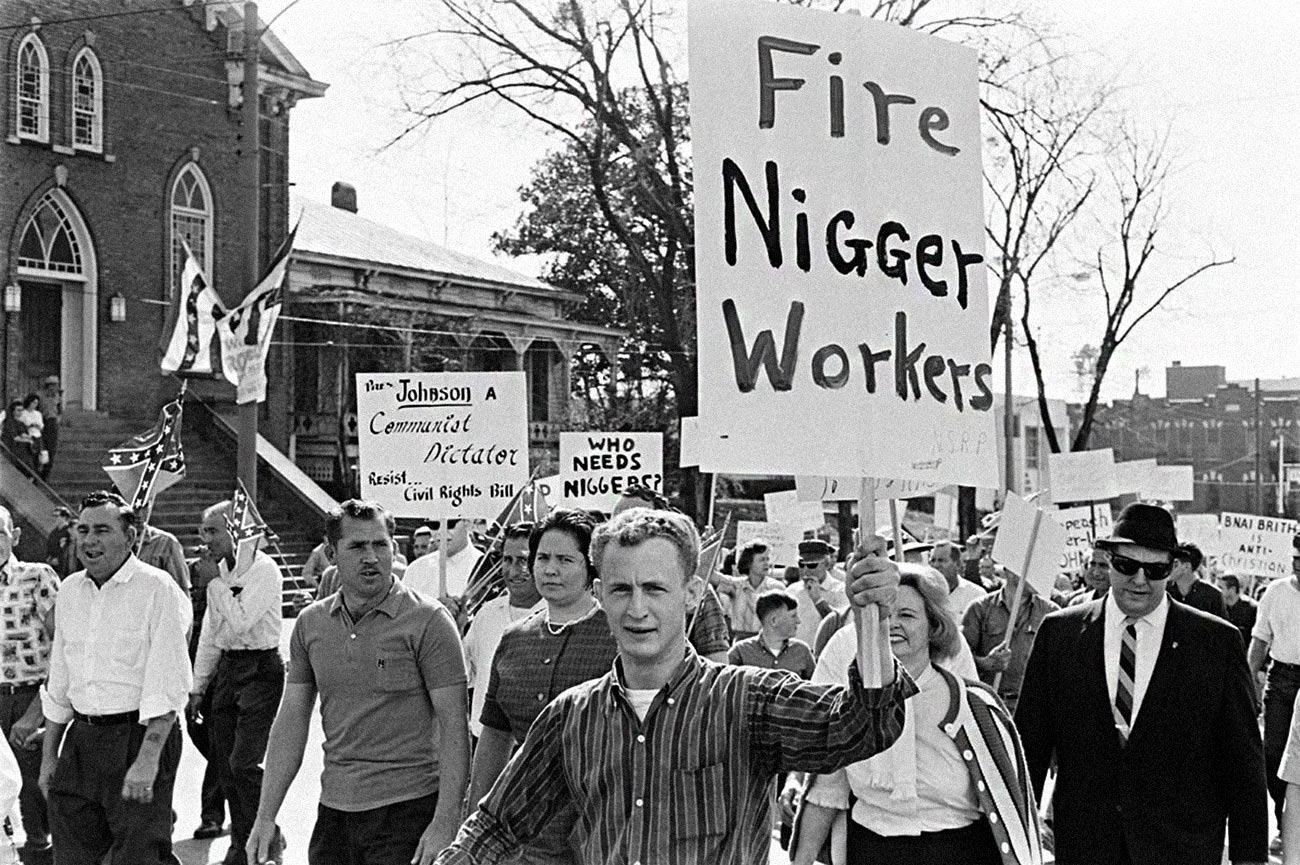
Pro-segregation march in Montgomery, Alabama, on March 17, 1965. (Glen Pearcy Collection, American Folklife Center, Library of Congress)
School segregation remains most deeply entrenched in the South. In Georgia, students at “integrated” Turner County High School attended private, segregated proms — one for Black students and one for white students — until 2007, and Wilcox County High
School did not hold its first integrated prom until 2013.
601
Atlanta (Ga.) CBS 46, “White Prom Still Takes Place in Wilcox
County,” May 29, 2013, http://www.cbs46.com/story/22086349/
wilcox-county-white-prom.
Alabama’s constitution still mandates separate schools for white and Black children because voters rejected repeal attempts in 2004 and 2012.
602
Editorial, Montgomery (Ala.) Advertiser, “Racist Language Must Be
Deleted,” June 17, 2003; “Alabama Separation of Schools, Amendment
2” (2004), https://ballotpedia.org/Alabama_Separation_of_Schools,_
Amendment_2_(2004); Alex Seitz-Wald, “Alabama: Where Jim
Crow Survives,” Salon, June 13, 2012; Campbell Robertson, “Alabama
Simmers Before Vote on its Constitution’s Racist Language,” New
York Times, October 31, 2012; “Alabama Segregation Reference Ban
Amendment, Amendment 4” (2012), https://ballotpedia.org/Alabama_
Segregation_Reference_Ban_Amendment,_Amendment_4_(2012).
The constitutional provision reads: “Separate schools shall be provided
to white and colored children, and no child of either race shall be
permitted to attend a school of the other race.” Alabama Const. Sec.
256 (1901).
Alabama schools remain deeply separate and unequal: 90 percent of students attending Alabama’s 75 failing schools in 2018 were African American.
603
Alabama Department of Education Public Data Reports (2017- 2018), https://www.alsde.edu/dept/data/Pages/home.aspx
The undeniable impact of valiant civil rights leaders and the many people who joined marches, boycotts, sit-ins, picket lines, voter registration drives, and freedom rides is reflected in the opportunities and achievements that people of color have accumulated
since the Civil Rights Movement.
At the same time, collective action in opposition to civil rights — from rallies and town meetings to bombings and riots — strengthened the bedrock narrative of white supremacy upon which the architects of civil rights opposition constructed
the modern apartheid state.
Months before infamous segregationist James O. Eastland died in 1986 in his native Sunflower County, Mississippi, amid the wind-whispered memories of a brutal lynching, he expressed no regret. “I voted my convictions on everything.”
604
Marjorie Hunter, “James O. Eastland is Dead at 81; Leading Senate
Foe of Integration,” New York Times, February 20, 1986.
Because our nation failed to confront the narrative of racial difference in the decades after the assassinations of national civil rights leaders and the rise of politicians opposed to civil rights signaled the end of the Civil Rights
Movement, white opposition rebranded itself while racial inequality grew.
In 2016, the rate of African American unemployment (8.4 percent) was nearly double the rate for white Americans (4.3 percent). 605 Bureau of Labor Statistics, “Unemployment Rate and Unemployment-Population Ratio Vary by Race and Ethnicity,” January 13, 2017, https://www.bls.gov/opub/ted/2017/unemploymentrate-and-employment-population-ratio-vary-by-race-and-ethnicity. htm. A 2017 study concluded that “discrimination against Black job applicants hasn’t changed since the 1990s.” 606 Lincoln Quillian, et al., “Hiring Discrimination Against Black Americans Hasn’t Declined in 25 Years,” Harvard Business Review, October 11, 2017. In part due to high rates of joblessness, 22 percent of African Americans live in poverty, compared to 9 percent of white Americans. 607 The Henry J. Kaiser Family Foundation, “Poverty Rate by Race/ Ethnicity, State by State” (2016), https://www.kff.org/other/stateindicator/poverty-rate-by-raceethnicity/. The racial wealth gap nearly tripled between 1984 and 2009, and today, for every $100 of wealth held by a white family, a Black family has just $5.04. 608 Editorial, New York Times, “Black and White Wealth Gap Perceptions,” September 18, 2017.
For a fleeting moment, racial justice challenged the American conscience and became a critical issue for this nation. But a generation later, racial injustice was again a burden that Black communities bore in resegregated isolation, while many white Americans
actively defended the status quo or avoided serious engagement with racial issues entirely.
The number of white adults reporting “no interest” in the issue of employment discrimination against Black Americans rose from 13 percent in 1964 to 34 percent in 2000.
609
Tyrone A. Forman and Amanda E. Lewis, “Beyond Prejudice?
Young Whites’ Racial Attitudes in Post-Civil Rights America, 1976 to
2000,” American Behavioral Scientist 59, no. 11 (2015): 1400.
“[T]he expression of racial apathy in the post-civil rights era is one new way in which white Americans can deny having negative feelings toward racial minorities while indirectly supporting the racial status quo.”
610
Ibid., 1401.
38 percent of white Americans agreed that the nation has already made the changes necessary to achieve equal rights while only 8 percent of Black Americans said the same.
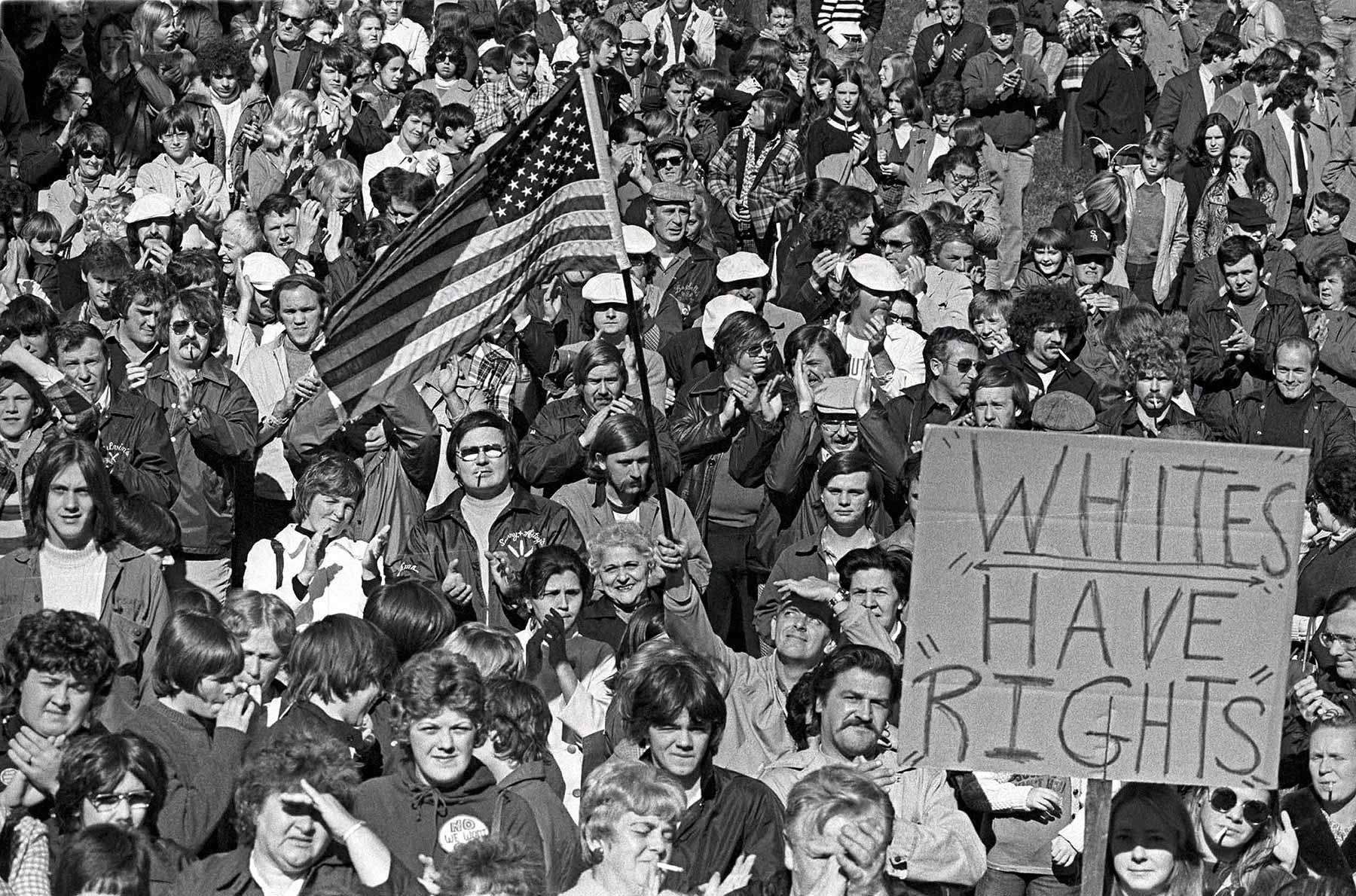
A large crowd gathers in South Boston to protest federal busing orders on September 12, 1974. Visible among the crowd because of their trademark white hats is the South Boston Information Center, a white militant anti-busing organization. (Spencer Grant/Getty)
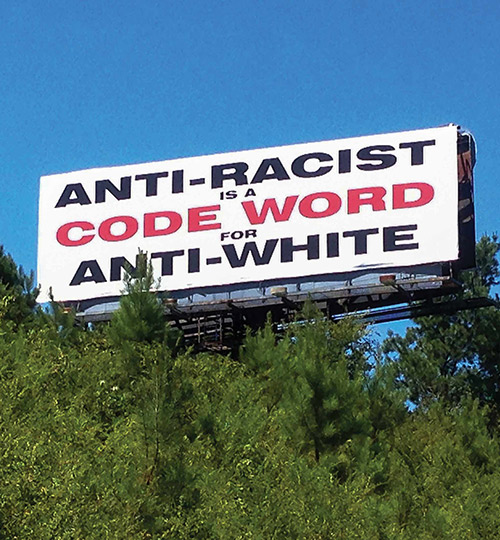 Billboard posted on an Alabama highway in 2014. (Bernard Troncale)
More recently, a 2016 Pew Research Center poll reported wide gulfs in views on race relations: 38 percent of white Americans agreed that the nation has already made the changes necessary to achieve equal rights while only 8 percent of Black Americans
said the same.
611
Pew Research Center, “On Views of Race and Inequality, Blacks and
Whites Are Worlds Apart,” June 27, 2016, http://www.pewsocialtrends.
org/2016/06/27/on-views-of-race-and-inequality-blacks-and-whitesare-worlds-apart/.
Billboard posted on an Alabama highway in 2014. (Bernard Troncale)
More recently, a 2016 Pew Research Center poll reported wide gulfs in views on race relations: 38 percent of white Americans agreed that the nation has already made the changes necessary to achieve equal rights while only 8 percent of Black Americans
said the same.
611
Pew Research Center, “On Views of Race and Inequality, Blacks and
Whites Are Worlds Apart,” June 27, 2016, http://www.pewsocialtrends.
org/2016/06/27/on-views-of-race-and-inequality-blacks-and-whitesare-worlds-apart/.
In the same study, 41 percent of white respondents said too much attention is paid to race these days, and just 19 percent of white respondents (in contrast with 70 percent of Black respondents) agreed that institutional discrimination
is a bigger problem than individual prejudice.
612
Ibid., 11, 36.
“Perhaps I was too optimistic,” Dr. King wrote in his Letter from a Birmingham
Jail, five years before he was assassinated on a Memphis hotel balcony. “Perhaps I expected too much. I suppose I should have realized that few members of the oppressor race can understand the deep groans and passionate yearnings of the oppressed
race, and still fewer have the vision to see that injustice must be rooted out by strong, persistent and determined action.”
613
Jonathan Rieder, Gospel of Freedom: Martin Luther King, Jr.’s Letter
from a Birmingham Jail and the Struggle That Changed a Nation (New
York: Bloomsbury Press, 2013), 180.